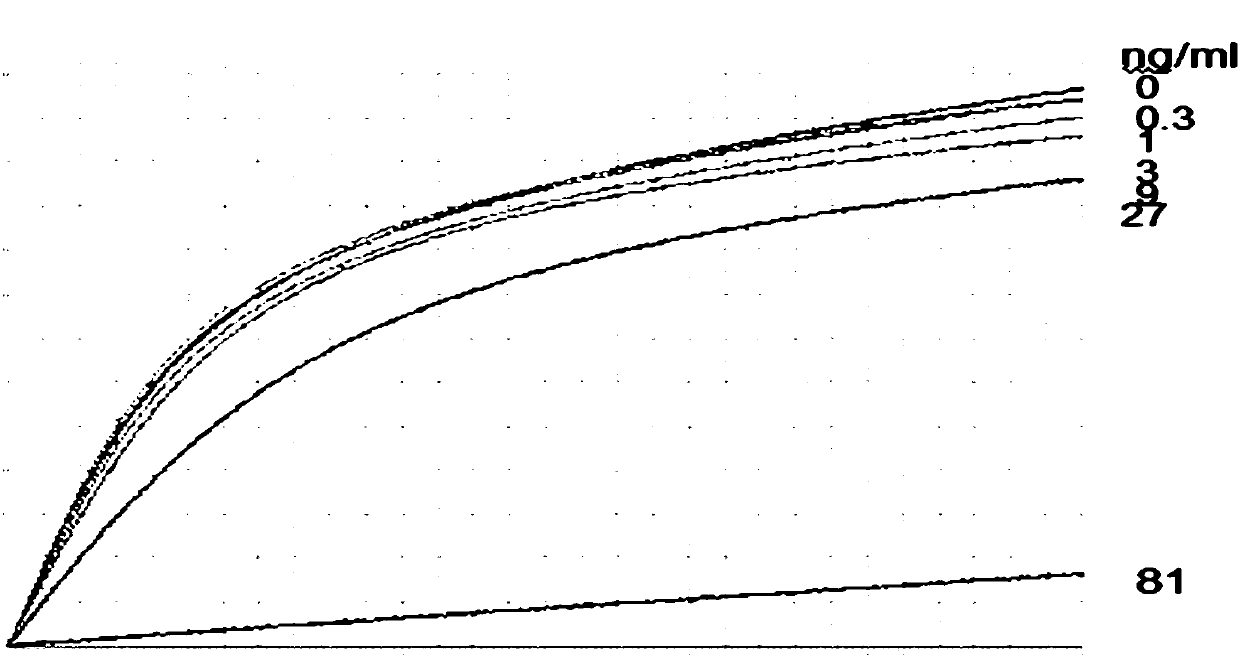Organophosphorus detection method based on interference spectrum analysis
A detection method and interference spectroscopy technology, which are applied in the field of organophosphorus detection based on interference spectroscopy analysis, can solve the problems of false negative/positive by immune method, high cost of instruments and equipment, influence of enzyme inhibition method, etc.
- Summary
- Abstract
- Description
- Claims
- Application Information
AI Technical Summary
Problems solved by technology
Method used
Image
Examples
Embodiment 1
[0026] Example 1: A detection method for organophosphorus based on interference spectrum analysis
[0027] Synthesis of general immunogen and coating agent of organophosphorus pesticides:
[0028] Synthesis of coated original conjugates: Weigh 0.88g of 4-hydroxybenzoic acid and dissolve it in 50 mL of methanol containing 0.90 g of KOH, add dropwise (within 5min) 1.81g of diethoxyphosphorous thiol under stirring at 0°C acid chloride, heated to 65°C, and stirred for 18 h. After the reaction was completed, the reactant was concentrated by rotary evaporation, and the obtained crude product was dissolved in ethyl acetate (20-30mL), extracted three times with 50mL 2mol / L NaOH solution, and the aqueous phase was acidified with 6mol / L hydrochloric acid until precipitation occurred. Washing with water yielded 1.05 g of the hapten. Dissolve 0.12 mmol of hapten in 2 mL of DMF, stir and add 0.14 mmol each of N,N'-dicyclohexylcarbodiimide (DCC) and N-hydroxysuccinimide (NHS), and react w...
Embodiment 2
[0035] Example 2: A detection method for organophosphorus based on interference spectrum analysis
[0036] A rapid test method for residual organophosphorus pesticides, in which a detection device is used, the detection device includes a sample pool, an optical fiber biosensor modified by a substrate carrier, an optical fiber connector and a spectrum analyzer, and is characterized by The general organophosphorus hapten prepared by the water-soluble carbodiimide method is then coupled with bovine serum albumin and chicken ovalbumin respectively, and the obtained conjugates are modified on the optical fiber biosensor to measure the content of organophosphate in the sample solution . The optical fiber biosensor modified by the substrate carrier has a carrier conjugate immobilized on the surface of the bottom of the fiber optic probe, and the conjugate is prepared by coupling with bovine serum albumin with diethylphosphonic acid acetic acid as a hapten. Originally, the modified f...
Embodiment 3
[0051] Example 3: A detection method for organophosphorus based on interference spectrum analysis
[0052] An optical sensor detection method for rapid detection of residual organophosphorus pesticides, said method comprising the steps of:
[0053] Synthesis of immunogen conjugates: Weigh 0.88g of 4-hydroxybenzoic acid and dissolve it in 50 mL of methanol containing 0.90 g of KOH, add dropwise (within 5min) 1.81g of diethoxyphosphoryl thiochloride under stirring at 0°C , heated to 65°C, and stirred for 18 h. After the reaction was completed, the reactant was concentrated by rotary evaporation, and the obtained crude product was dissolved in ethyl acetate (20-30mL), extracted three times with 50mL 2mol / L NaOH solution, and the aqueous phase was acidified with 6mol / L hydrochloric acid until precipitation occurred. Washing with water yielded 1.05 g of the hapten. Dissolve 0.12 mmol of hapten in 2 mL of DMF, stir and add 0.14 mmol each of N,N'-dicyclohexylcarbodiimide (DCC) and ...
PUM
| Property | Measurement | Unit |
|---|---|---|
| Sensitivity | aaaaa | aaaaa |
Abstract
Description
Claims
Application Information
 Login to View More
Login to View More - R&D
- Intellectual Property
- Life Sciences
- Materials
- Tech Scout
- Unparalleled Data Quality
- Higher Quality Content
- 60% Fewer Hallucinations
Browse by: Latest US Patents, China's latest patents, Technical Efficacy Thesaurus, Application Domain, Technology Topic, Popular Technical Reports.
© 2025 PatSnap. All rights reserved.Legal|Privacy policy|Modern Slavery Act Transparency Statement|Sitemap|About US| Contact US: help@patsnap.com

